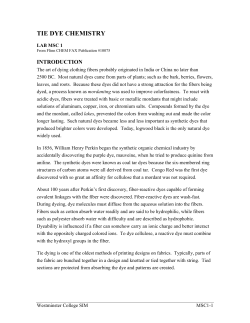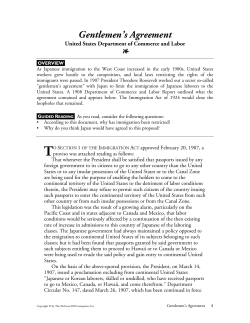
Ikat, Kasuri and E-gasuri Background and Techniques
Ikat, Kasuri and E-gasuri Background and Techniques
by
Jeffrey Krauss
[Originally presented at the opening of the exhibition of antique picture kasuri (Japanese term for
ikat) textiles from the collection of Jeffrey Krauss, which took place June 12, 2006 at the Japan
Information and Culture Center, Washington DC.]
Introduction
Kasuri 絣 is the Japanese name for the resist dyeing technique called ikat (pronounced
ee-kaht) in other parts of the world. Threads were bundled and portions of the thread
bundles were covered with dye-resistant material so that the dye could not penetrate
("resist-dyed") before the fabric was woven. After unbundling, the dyed and undyed edges
don’t line up exactly in the weaving process, resulting in a blurred or “splashed” effect.
Both in Japan and throughout the world, ikat or kasuri-dyed textile designs were most
often abstract or geometric. But in Japan, craftsmen developed the skill of making picture
kasuri (e-gasuri 絵絣). Futon covers, sleeping blankets and jackets carried woven pictures
of auspicious symbols, signs of prosperity and longevity: pine, bamboo and plum
blossoms; cranes and tortoises; lobsters; paulownia leaves; noshi; gods like Daikoku, Hotei
and Ebisu; legends and legendary figures like Takasago (legend of an old married couple),
Daruma (the father of Zen Buddhism) and Shojo (fantastic underwater creatures); and
fantastic devices like treasure bags, magic jewels and wish-granting mallets.
Resist Dyeing Techniques
Resist dyeing is a patterning technique in which sections of the warp threads, the weft threads or
the woven cloth are covered or reserved, in order to prevent dye from penetrating.
They may be covered with various kinds of materials or forms. For example, they may be covered
with wax; the Japanese term for that technique is rozome.
Or they may be covered with a starch paste made from rice, squeezed out of a device like a pastry
tube; that is called tsutsugake in Japan.
If dye-resistant materials are used to cover threads before the fabric is woven, that is called kasuri.
The dye-resistant material used to be tree bark, but then plastic tapes came into use.
In addition, stitching or pleating may be used to prevent dye from penetrating portions of the fabric,
a technique known as shibori.
In some parts of Japan a technique employing stencils was used, known as bingata.
1
Or, fabric or threads could be clamped between wooden boards to keep the dye from penetrating
certain areas, a process called itajime.
This essay is about the resist dye technique known as ikat or kasuri, and how it was produced. The
basic concept of kasuri is shown in this picture, from Tomita:
In this example, bundles of weft threads have
some material wrapped around them to
prevent the dye from penetrating. After the
bundles of threads are dyed, and then
unwrapped from the bundles and woven into
a fabric, a variety of patterns are possible,
depending on the order in which the weft
threads are used.
This is what the threads look
like after they are dyed and
after the resist has been
removed but before being
woven.
The technique of tying the resist, then dyeing the threads, then removing the resist and weaving the
fabric is very time consuming and labor intensive. While the kasuri technique was popular for
futon covers and jackets or yukatas in the first half of the 20th century, its use declined after that.
2
Today kasuri is hardly made at all and the few remaining kasuri craftsmen are widely respected.
One of them is Shoji Yamamura, a prize-winning kasuri weaver and indigo dyer from Kurume, on
Kyushu. He exhibited his textile creations at the Japan Information and Culture Center in 2003.
This is a picture of him doing the resist tying of the threads:
3
Here is a picture of boys tying ikat resist around bundles of threads, probably in India:
4
Here is another example of ikat resist being tied:
5
And another example:
6
This is a picture of women in Japan tying a very long bundle of threads, with resist tied at various
places along the length:
7
Ikat Around The World
Ikat dyeing techniques were not limited to Japan, they have been employed throughout the world.
Here is a simple example from Africa:
8
This is a more complex example, from a Chinese minority people, the Li People of Hainan Island.
In addition to the indigo-dyed ikat, it shows a weaving technique called extra-weft brocading . The
ikat here makes a pattern that might appear as interlocked waves or undulations.
This is a picture of an Ecuadorian woman who is weaving ikat, using a backstrap loom.
9
This is a scan of silk ikat made in Thailand. It comes from a shirt purchased in Chiang Mai from a
shop that makes patchwork shirts out of remnants of old silk textiles.
The origin of that material may have been from an ikat sarong like this:
10
Here are examples of ikat from Timor and Indonesia in Southeast Asia. While the previous
examples were geometric designs, these show figure of animals:
11
Perhaps the most beautiful ikat in the world was made in Uzbekistan, around a hundred years ago.
Here is a section of a panel:
It probably came from a garment that looked something like this:
12
Kasuri and E-gasuri from Japan
Origins of Kasuri in Japan
There are different theories about how ikat came to Japan. Ikat textiles from the seventh and
eighth centuries found their way to Japan, probably from China, Korea or Southeast Asia, and
fragments are preserved in the Shosoin Repository of the Todaji temple in Nara. But there does
not seem to be any connection between those pieces and the origins of kasuri weaving in Japan
which may have occurred during the Muromachi period 1392-1573, Momoyama Period
(1573-1603) or Edo period (1603-1868).
Ikat techniques may have been brought to Japan by international maritime trade during the 14th
century. It may have come from India, via Java, Borneo, the Philippines, Taiwan, the Ryukyu
islands. From there, it could have been introduced into Japan via Kyushu and Shikoku, and
disseminated throughout Japan. Or it may have come to Japan from India via the Philippines into
Nara, Japan, and then disseminated. Or it may have come from India via China and Korea into the
San-in district of Japan, and then disseminated.
But there are also stories about kasuri being invented independently in Kurume around 1800. Or
it may have been invented in Iyo on Shikoku, also in the early 19th century.
Examples of Kasuri
So we have seen examples of ikat from other parts of the world. Here are examples of Japanese
kasuri. The first is an example of a fine dot pattern, known as “mosquito kasuri”:
13
Here is an example of a design that is more complex, but still geometric in nature. There are
literally thousands and thousand of design like this:
Here is another example of a geometric pattern, this using a brown dye rather than indigo:
14
Here is an example that is still more complex, but still geometric. It uses red dye in addition to
indigo.
This last piece probably comes from the region known as Bingo, on the Inland Sea side of western
Honshu, comprising what is today the eastern part of Hiroshima Prefecture. Because of the use of
red dye, this is probably from around the 1940s or 1950s.
15
E-gasuri
Picture kasuri, or e-gasuri, can be classified in several different ways. For example, with some
kinds of picture kasuri the picture is made up of big geometric blocks, placed together to make a
picture. The futon cover in the following picture is made up of four panels of fabric, each about 13
inches wide, and each panel is different. They are sewn together so that, when viewed from a
distance, they make up a picture, in this case a picture of a castle or temple.
16
The large geometric blocks indicate that this piece came from Kurume, on the island of Kyushu.
The geometric blocks are a combination of warp kasuri and weft kasuri.
The next class of e-gasuri pieces also contain geometric blocks, but they do not form a picture.
Instead, the pictures (of cranes, in this example) are achieved solely by weft kasuri. The geometric
blocks are, once again, a combination of warp kasuri and weft kasuri. And again, this piece comes
from Kurume.
17
There is another class of e-gasuri pieces that contain both geometric designs and picture designs,
but where the geometric portion is delicate rather than blocky. They come from Hirose, in
Shimane Prefecture located along the Sea of Japan coast. Here is an example of carp pictures
produced this way:
18
The next e-gasuri class contains no geometric designs at all, and no warp kasuri. The following
example, also of carp, is solely weft kasuri. It probably comes from either Iyo on Shikoku, or from
Yumigahama on Honshu.
19
This is another example of a panel with no warp kasuri, only weft kasuri. In addition to the
pictures, it also contains stripes, but the stripes consist of solid white warps and wefts, not resist
dyed. This also comes from either Iyo on Shikoku, or from Yumigahama on Honshu.
20
All of the e-gasuri panels above are done on cotton. But kasuri resist dyeing was also applied to a
fabric called “asa” in Japan, which comes from the hemp or ramie family. It more formally known
as bast, and is related to linen. The thread is made from the inner bark of a plant. E-gasuri using
asa was made in a few places in Japan. This next piece probably came from Omi, near Lake Biwa,
northeast of Kyoto.
Some very finely detailed patterns were achieved on asa.
21
The following map shows where these e-gasuri production sites were located. Omi and Ni’igata
were generally the locations where hemp or ramie was used, and cotton was used at the others.
Kyoto and Tokyo are shown to help with orientation.
22
E-gasuri Techniques
How was it possible to make pictures like these using ikat techniques?
One way was to use a guide thread, a thread that was stretched back and forth between two
comb-like structures that hold the guide thread in place as if it were a weft thread. The distance
between the combs was roughly a loom-width, about 13 inches. Then the design was drawn on the
thread, using black ink, as shown in the picture below, taken from [source]. This thread was then
unreeled from the combs and was used as a guide to determine where to tie the resists.
23
There was another method used to create picture kasuri in Japan, using carved wooden boards.
Earlier I mentioned itajime, the use of boards clamped together, as a way to prevent dye from
penetrating. If the boards had patterns carved into them, then dye could be added into the
carved-out portions, or the boards could be dunked into vats of dye, so that threads in the carved
out portions would be dyed, while the uncarved portions of the boards would tightly clamp the
threads to prevent dye penetration. The following picture, from The Textile Museum Journal, is a
diagram of how that could be done.
24
And while this technique sounds bizarre, it was actually used very successfully. This picture, also
from The Textile Museum Journal, shows it in operation:
And why was this technique used? Because the boards were only carved once, and then could be
used again and again. This is in contrast to hand-tying, which had to be done for each bolt of cloth.
This carved board technique speeded up the process, because it was the resist tying that was so
time-consuming. This was an early form of mechanization.
25
One way to identify an e-gasuri piece that was made using carved boards is by looking near the
selvage. A white bar indicates the use of itajime, because sections of the board near the edges
remained uncarved and formed ridges, in order to assure stability. Here are two examples:
There is another approach to creating ikat or ikat-like textiles, an even more mechanized approach,
by means of stencils. Warp the loom, without weaving any weft threads through it, then put a
stencil on, apply dye through the stencil, and then remove the stencil. If you were to weave the
weft threads at this point, it would look like a pattern was printed onto the warp threads, because
the edges between the dyed and undyed parts of the warp threads would line up exactly. But if you
were to unwind the warp threads and then warp the loom again, the dyed edges would not line up
exactly any more, It would appear just like warp ikat.
You could do the same thing with weft threads. You could set up a loom, use only a few warp
threads to create selvages, and weave the weft threads back and forth. Then apply a stencil, apply
dye through it, remove the stencil, unwind the weft threads and finally weave them through warp
threads on a loom. Once again the edges between dyed and undyed areas, this time on the weft
threads, would no longer line up exactly. It would look like weft ikat.
26
Here is an example from a child’s jacket that was probably dyed that way:
27
The Collection
My collection consists almost entirely of indigo-dyed textiles, although it includes some pieces
that use brown dye instead of indigo, or use red dye in addition to indigo. They are mostly futon
covers, or single panels from futon covers. Futon covers are generally four or five panels wide,
they have a plain backing fabric, and the futon goes inside. Japanese dealers buy futon covers at
auctions in Japan, and then take off the backs and separate them into 4 or 5 panels, which they sell
individually.
The collection also includes some garments, such as jackets and yukatas, and a yogi. A yogi is a
sleeping blanket, configured like a huge coat, but stuffed with padding for insulation.
It contains about 200 different designs of auspicious symbols. That is, 200 different designs by
different kasuri weavers, but not 200 different symbols. Many renditions of cranes and tortoises
were created, and the collection includes several different renditions. The collection includes a
number of renditions of pines, plum blossoms and bamboo, and similarly a number of renditions
of koi, of castles, of paulownia leaves, etc.
Collecting e-gasuri is not like collecting stamps or coins. There is no catalog that lists all the
varieties. It is simply not possible to amass a complete collection, even for collectors in Japan.
There are an infinite number of different cranes and tortoises renditions, and an infinite number of
pines, plums and bamboo.
Here is an example of two renditions of daruma, the Japanese name for the founder of Zen
Buddhism, similar but not identical.
28
So once you begin a collection, there is no need to ever stop!
29
Recommended Sources for More Information
The Textile Museum Journal, 1978
Beyond the Tanabata Bridge: Traditional Japanese
Textiles, Rathbun, William Jay
This volume is an authoritative guide to folk textiles of
Japan from the 18th to 20th century based on one of
America's most comprehensive collections at the
Seattle Art Museum. Illustrated are Ainu textiles,
sashiko, kogin and hishizashi, kasuri, shiborizome and
koshi patterns, and textiles of Okinawa.
Seattle Art Museum 1993, ISBN 0932216404
30
Daruma 34 Volume 9 No. 2
Tokyo, Spring 2002.
· San’in Kasuri
Daruma 44 Volume 11 No. 4
Tokyo, Autumn 2004.
· Kurume-gasuri
Japanese Ikat Weaving
Tomita, Jun and Noriko,
Publisher: Routledge &
Kegan Paul, 1982 ISBN:
0710090439
31
Ai no Hana Orinasu
Kasuri--Horiuchi Izuho
Collection
by Horiuchi Izuho
Publisher: Senshoku to Seikatsu
sha; (1998/04) ISBN:
4915374343
32
Bibliography
Books
Ai no Hana Orinasu Kasuri--Horiuchi Izuho Collection, by Horiuchi Izuho, Publisher: Senshoku to Seikatsu sha;
(1998/04) ISBN: 4915374343
Beyond the Tanabata Bridge : traditional Japanese textiles by Rathbun, William J., ed., New York & London : Thames
and Hudson, Seattle Art Museum, 1993 ISBN: 0932216404
Flowers, Dragons and Pine Trees, Asian Textiles in the Spencer Museum of Art, Mary M. Dusenbury, Hudson Hills
Press, New York 2004 ISBN 1-55595-238-0
Japanese country textiles by Jackson, Anna, London : V & A Publications, 1997 ISBN: 1851772162
Japanese folk textiles : an American collection (Fifi White collection), Shikosha, [1987] ISBN: 4879405043
Japanese ikat weaving : the techniques of, by Tomita, Jun and Noriko, 1951-London ; Boston : Routledge & Kegan
Paul, 1982. ISBN: 0710090439
Japanese indigo design, The Collecion of Sadako Fukui by Fukui, Sadako
Kyoto : Kyoto Shoin Co., Ltd., 1992 ISBN: 4763660454
Japanese textiles in the Victoria and Albert Museum by Jackson, Anna
London : V&A Publications, 2000 ISBN: 1851773169
Kasuri No Michi; Fujimoto Collection, published by Mainichi Shimbun-sha, Showa 59.
Mingei, Japanese Folk Art from the Montgomery Collection, Moes, Robert and Amanda Mayer Stinchecum,
Alexandria VA 1995 ISBN: 0883971178
The Dyer's Art : ikat, batik, plangi / Jack Lenor Larsen ... [et al.] ; photos. by Bob Hanson. New York : Van Nostrand
Reinhold, 1976. ISBN: 0442246854
Traditional Ikat (Kasuri) Design Collection, Kamon Yoshimoto, Research Association for Old Textiles, ISBN:
4766102991
Articles
"Japanese ikat textiles" by Langewis, Jaap., Kultuurpatronen 1960 Delft : Ethnografisch Museum, 1960.
"Kasuri, a Japanese Textile", by Mary Dusenbury, Textile Museum Journal, Volume 17 1978, p.41
"Kurume-gasuri" by Horiuchi Izuho, Daruma 44 Volume 11 No. 4 Fall 2004
"San'in Kasuri" by Ichimichi Kazutoyo, Daruma 34 Volume 9 No. 2 Spring 2002
"The Effect of Western Textile Technology on Japanese Kasuri," by Keiko Kobayashi, Textile Museum Journal, vol.
40/41, p. 1
33
© Copyright 2025



















